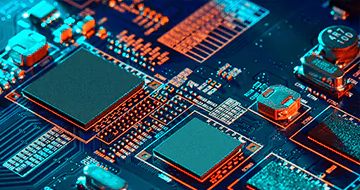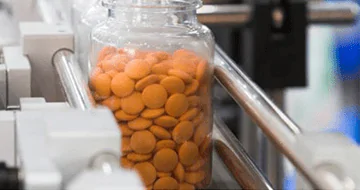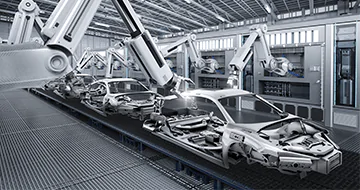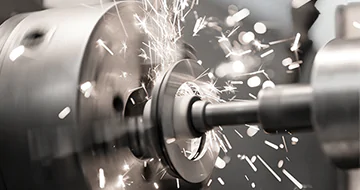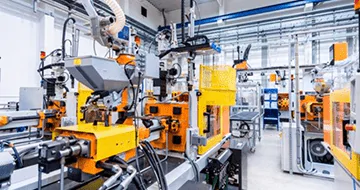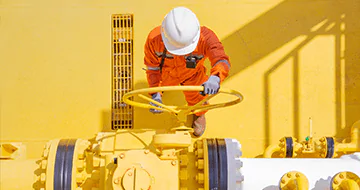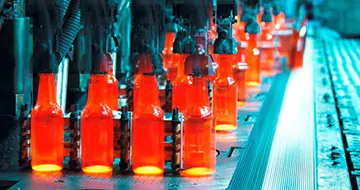Teknolojik Yenilikler ve İzlenebilirlik Sisteminin Gelişimi
OCR'nin Yaygınlaşması, 2D Kodlar ve Doğrudan İşaretleme ve İzlenebilirliğin Geliştirilmesi
İzlenebilirlik işlemi artık zorunlu bir görev haline gelmiştir. Etiketler ve işaretler kullanılarak yapılan tanımlamaya ek olarak, her şirketin bilgi ve nesneler arasındaki bağlantıya dayanarak kendi yönetim şeklini benimsediğini söyleyebiliriz.
İzlenebilirlik işleminin yaygınlaşmasını sağlayan itici gücün, özellikle, doğru bir şekilde işaretleme ve okuma teknikleri sağlayan ve bu tür bilgilerin kapsamlı bir şekilde işlenmesine izin veren BT teknolojilerindeki önemli gelişme olduğu söylenebilir. Bu nedenle, bu bölümde izlenebilirlik sistemlerinin gelişimini destekleyen teknolojik yeniliklere ışık tutulmuştur.
Geliştirilmiş Tanımlama Doğruluğu/Güvenilirliği
İzlenebilirlik işleminde, parçaları ve ürünleri belirleyebilmek amacıyla tanımlama sembolleri kullanılır. Üretim kontrolünün yapıldığı yerde, teslimat durumunu, üretim planlarını, tedarik planlarını, sevkiyat planı başarı oranlarını, stok miktarlarını ve yönetimle ilişkili diğer bilgileri kaydetmek için karakterler ve 2D kodlar gibi tanımlama sembolleri kullanılır. Bu amaç doğrultusunda, tanımlama sembollerini doğru bir şekilde belirleyebilen teknolojiler önem kazanmıştır.
PCB üzerine işaretlenen küçük karakterler ve 2D Kodları
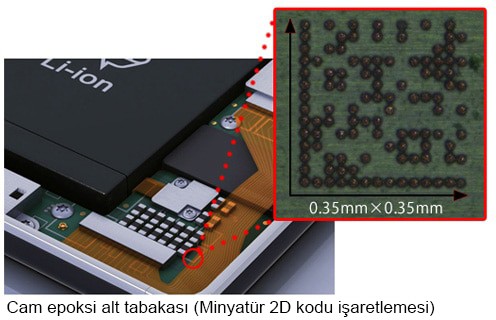
Boru/çubuk gibi kavisli bir yüzeye sahip bir nesneye yapıştırılmış etiketler

İnce metal yüzeyli veya döküm yüzeyli malzemeler üzerine işaretlenmiş 2D kod

Yukarıda gösterilen karakterler ve 2D kodlar, okuma hatalarına karşı oldukça hassastır. Ancak son yıllarda, taşınabilir mobil bilgisayarların ve barkod okuyucuların okuma doğruluklarının gelişmesi sayesinde doğru ve güvenilir tanımlama mümkün hale gelmiştir.
Gelişmiş Karakter Tanımlama Doğruluğu/Güvenilirliği için OCR Teknolojisinin Gelişimi
TOCR (Optik Karakter Tanıma) teknolojisinin gelişimi, son kullanma tarihleri ve parça numaraları gibi karakterlerin doğru bir şekilde okunabilmesini ve kaydedilebilmesini mümkün kılmıştır. Güvenliğin önemi konusunda bilinçlenme artışına bir örnek olarak, gıdaların son kullanma tarihlerinin artık yalnızca belirli bir tarihi değil aynı zamanda üretim zamanı aralığını da içermesi verilebilir. Bu durumda, bilgi miktarındaki artış üretim sahasında daha fazla iş gücü gerektirse de okuma sürecinde kullanılan OCR tabanlı otomasyon hem iş gücü hem de güvenlik sorunları için bir çözüm olabilir.
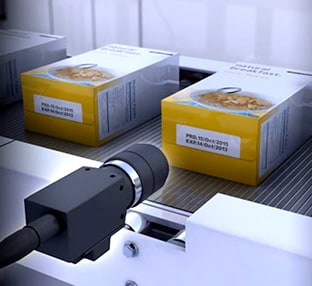
OCR Nedir?
OCR, herhangi bir görüntüde bulunan karakterleri tanımaya yönelik geliştirilen bir teknolojidir. Bir izlenebilirlik sistemi, kamera sayesinde hedefin görüntüsünü yakalar. Daha sonra ise yakalanan görüntüdeki karakterleri tanır ve karakter olarak okuyabilmek için şekillerini kayıtlı sözlükteki (karakter yazı tipi grubu) verilerle karşılaştırır. Bu uygulama, son kullanma tarihlerinin veya parça numaralarının tanımlanabilmesi ve kaydedilebilmesi için önemli bir teknoloji haline gelmiştir. Ayrıca, görsel okuma ve manuel giriş kaynaklı hataların önlenebilmesi için de etkili bir çözüm olarak gösterilebilir.
Bir tür görüş sistemi tarafından yapılan değerlendirmenin sonuçlar

Yerden Tasarruf Sağlayan 2D Kodlar
İzlenebilirliği uygulayabilmek adına ürüne parça numaraları, miktar, seri numarası ve gönderi hacmi gibi çeşitli bilgileri eklemek gerekmektedir. Ancak, standart barkodlar bu tür bilgilerin tümünü içeremez. Buna karşın, 2D kodlar sınırlı bir alanda standart barkodlarla karşılaştırıldığında daha fazla bilgi depolayabilir ve izlenebilirlik dahil olmak üzere parça ve ürün yönetimi için de kullanılır. Minyatürleştirme ve daha yüksek yoğunluk gerektiren elektronik cihazların PCB’leri gibi sınırlı alana sahip bileşenlerde bile bunları işaretleyerek güvenilir bireysel yönetim elde etmek için 2D kodları kullanabilirsiniz.

Esnekliği Arttırmak için Doğrudan Parça İşaretleme
Doğrudan parça işaretleme (DPM), seri numaralarını, parti numaralarını ve 2D kodları doğrudan parçalara ve ürünlere işaretlemesinin yanı sıra izlenebilirlik sistemlerinin geliştirilmesine de büyük katkı sağlar. Dahası, yukarıda bahsedilen PCB üretim sahasında sahte çipler sosyal bir sorun haline gelmiştir. Bu nedenle, doğrudan parça işaretleme işlemi, bilgileri doğrudan parçalar üzerinde işaretleyerek bu soruna karşı bir önlem olarak yapılmıştır. Doğrudan parça işaretlemenin kombinasyonu ve 2D kodları, etiket yapıştırmak için yeterli yere olmayan bileşenlerde bile tanımlama sembollerinin gösterilmesini sağlamaktadır.

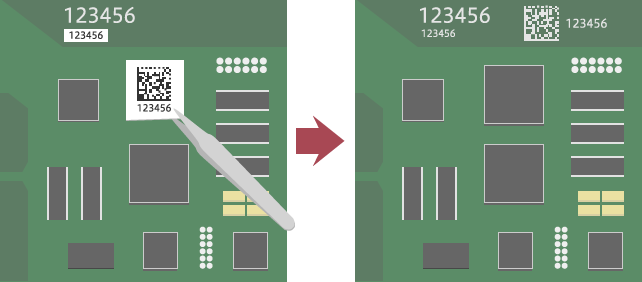
Doğrudan parça işaretleme, araba motorları ve şanzımanlar gibi yüksek sıcaklıklara maruz kalan ve dış ortamlarda uzun süre boyunca kullanılan ürünler için de uygundur. Ancak, bu tür ürünlere yapıştırılan etiketlerde soyulma veya renk değişimi gibi sorunlarla karşılaşılabilir. Buna karşın, doğrudan parça işaretleme, işlemi okuma hatasıyla ilgili endişeleri ortadan kaldırır.
İzlenebilirlik Kapsamını Genişletmeye Yönelik Yeni Teknolojilerin Akışı
OCR, 2D kodlar ve doğrudan parça işaretleme, izlenebilirliğin uygulanabilmesi amacıyla pek çok farklı şirket tarafından tanıtılmıştır. Elektronik etiketler ve radyo dalgaları kullanarak bilgi okumak/yazmak işlemleri için mürekkep püskürtmeli yazıcılar ve RFID ile baskı gibi diğer yeni teknolojiler kullanılmaya başlanmıştır.
BT teknolojilerinin evrimi, izlenebilirlik sistemleri ile MES (Manufacturing Execution Systems) ve ERP (Kurumsal Kaynak Planlaması) arasındaki koordinasyonu desteklediğinden sadece üretime değil, aynı zamanda iş etkinliğinin her türlü yönüne fayda sağlamaya başlamıştır. Dahası, bilgiler ağlar aracılığıyla yurt içi ve yurt dışı şirket ve tesislerle paylaşılabilir. Bu nedenle, izlenebilirliğin küreselleşmeyi desteklemek adına gün geçtikçe daha fazla dikkat çekeceği kesindir.
Tanımlama yöntemlerinin çeşitlendirilmesi ve bilgi kaydı ve aktarımının doğruluğunun artması sayesinde izlenebilirlik kapsamının daha da genişlemesi beklenmektedir.

